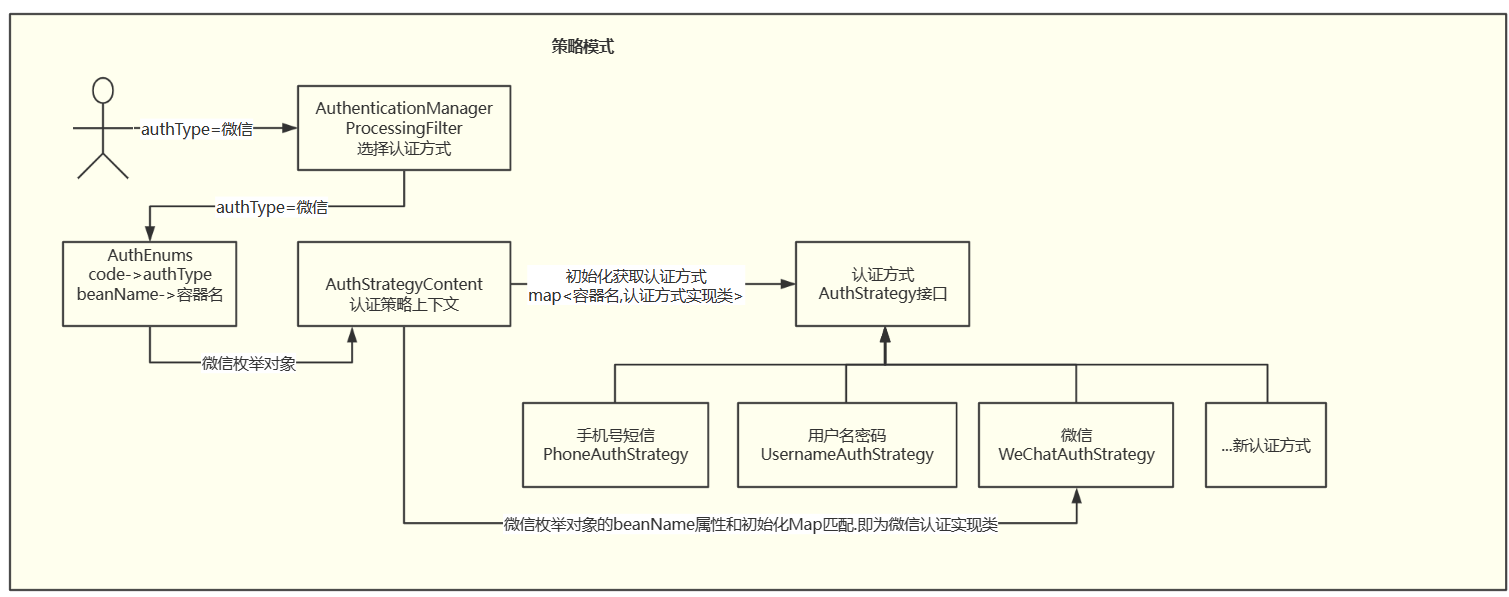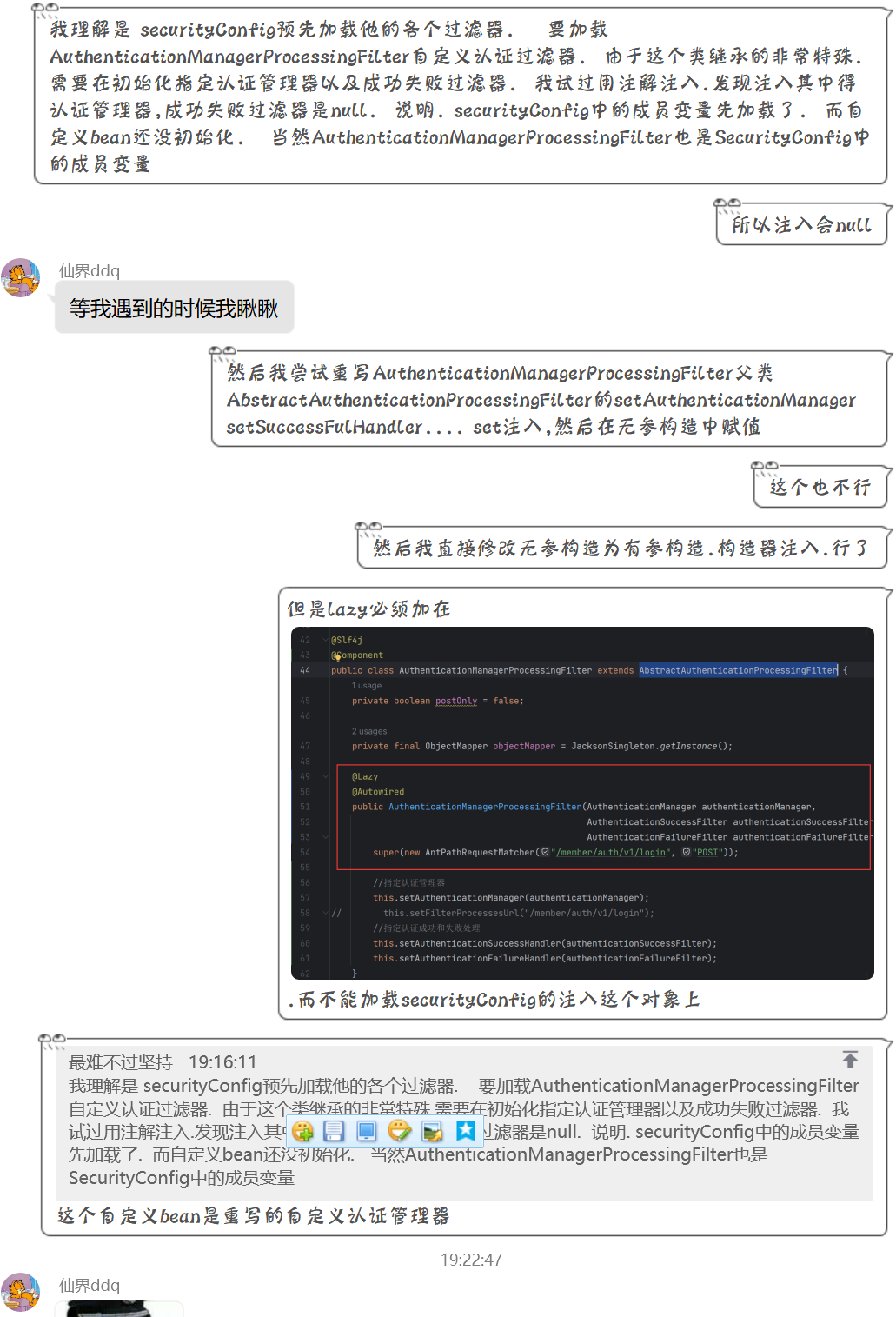您现在的位置是:首页 >技术交流 >SpringSecurity多源认证之全部交给spring容器网站首页技术交流
SpringSecurity多源认证之全部交给spring容器
简介SpringSecurity多源认证之全部交给spring容器
文章目录
一. 前言
相关文章:
认证/支付/优惠劵策略模式-security多源认证 这篇文章没有将自定义的认证管理器注入容器.
spring-security2.6.3+JWT认证授权 这篇文章描述了基本security架构.
如今这篇是全部交由spring security托管.但博主依然有一个问题不太清楚.放在文末.本篇文章基于认证/支付/优惠劵策略模式-security多源认证文章继续讲解
二. 配置流程
2.1 SecurityConfig.class
5.7版和旧版换汤不换药.我们以旧版继承WebSecurityConfigAdapter讲解.
/**
* @Description: spring security 配置类
*/
@Configuration //配置类
// 开启注解 @PreAuthorize @PostAuthorize @Secured
@EnableGlobalMethodSecurity(prePostEnabled = true, securedEnabled = true, jsr250Enabled = true)
public class SecurityConfig extends WebSecurityConfigurerAdapter {
// // 授权处理器
// @Resource
// private AccessDeniedHandlerImpl accessDeniedHandler;
// jwt过滤器
@Resource
private JwtAuthenticationTokenFilter jwtAuthenticationTokenFilter;
// 手机号短信登录
@Lazy
@Resource
private SmsCodeAuthenticationProvider smsCodeAuthenticationProvider;
// 手机号账号登录
@Lazy
@Resource
private MobileAccountAuthenticationProvider mobileAccountAuthenticationProvider;
// 微信登录
@Lazy
@Resource
private WeChatAuthenticationProvider weChatAuthenticationProvider;
@Resource
private DataSource dataSource;
@Resource
private AuthenticationManagerProcessingFilter authenticationManagerProcessingFilter;
//把AuthenticationManager暴露到工厂里面,就可以在任何位置注入,如果想暴露一定要把这个方法给注入到容器中
@Bean
@Override
//自定义登录过滤器交给工厂
public AuthenticationManager authenticationManagerBean() throws Exception {
return super.authenticationManagerBean();
}
@Bean
public PasswordEncoder passwordEncoder() {
return new BCryptPasswordEncoder();
}
//自定义AuthenticationManagerBuilder来选择自己的认证方式 推荐,AuthenticationManager并没有在工厂中暴露出来想使用得把她暴露之后再注入
@Override
protected void configure(AuthenticationManagerBuilder auth) throws Exception {
// auth.userDetailsService(userDetailService); 不采用默认username认证方式
auth
.authenticationProvider(smsCodeAuthenticationProvider)
.authenticationProvider(mobileAccountAuthenticationProvider)
.authenticationProvider(weChatAuthenticationProvider);
}
// 配置拦截规则 也可以在AuthenticationManagerAuthenticationProcessingFilter中配置
// private AuthenticationManagerProcessingFilter authenticationManagerProcessingFilter() throws Exception {
// AuthenticationManagerProcessingFilter authenticationManagerProcessingFilter =
// new AuthenticationManagerProcessingFilter();
// //指定认证管理器
// authenticationManagerProcessingFilter.setAuthenticationManager(authenticationManagerBean());
// authenticationManagerProcessingFilter.setFilterProcessesUrl("/member/auth/v1/login");
// //指定认证成功和失败处理
// authenticationManagerProcessingFilter.setAuthenticationSuccessHandler(authenticationSuccessFilter);
// authenticationManagerProcessingFilter.setAuthenticationFailureHandler(authenticationFailureFilter);
// return authenticationManagerProcessingFilter;
// }
/**
* anyRequest | 匹配所有请求路径
* access | SpringEl表达式结果为true时可以访问
* anonymous | 匿名可以访问
* denyAll | 用户不能访问
* fullyAuthenticated | 用户完全认证可以访问(非remember-me下自动登录)
* hasAnyAuthority | 如果有参数,参数表示权限,则其中任何一个权限可以访问
* hasAnyRole | 如果有参数,参数表示角色,则其中任何一个角色可以访问
* hasAuthority | 如果有参数,参数表示权限,则其权限可以访问
* hasIpAddress | 如果有参数,参数表示IP地址,如果用户IP和参数匹配,则可以访问
* hasRole | 如果有参数,参数表示角色,则其角色可以访问
* permitAll | 用户可以任意访问
* rememberMe | 允许通过remember-me登录的用户访问
* authenticated | 用户登录后可访问
*/
// @Override
// public void configure(WebSecurity web) {
// // 放行路径,不走过滤器链
// web.ignoring().antMatchers(
// "/member/**");
// }
@Override
protected void configure(HttpSecurity http) throws Exception {
//获取工厂对象
http
.authorizeRequests()
.mvcMatchers("/a/auth/**").permitAll()
.mvcMatchers("/test/**").permitAll()
.mvcMatchers("/a/book/v1/book/**").permitAll()
.mvcMatchers("/b/user/v1/list/**").permitAll()
.anyRequest().authenticated() // 除上述放行的url,其余全部鉴权认证
.and()
.cors()
.and()
.rememberMe()//记住我功能开启
.rememberMeParameter("remember")//修改请求表单中的的记住我标签name属性
.rememberMeServices(rememberMeServices())//指定remember的实现方式后端通过json
.tokenRepository(persistentRememberMeToken())
//用数据库的形式记住cookie
.and()
// 关闭csrf
.csrf().disable();
// http.exceptionHandling()
// .accessDeniedHandler(accessDeniedHandler);
http.addFilterBefore(authenticationManagerProcessingFilter,
UsernamePasswordAuthenticationFilter.class)
.addFilterBefore(jwtAuthenticationTokenFilter,
AuthenticationManagerProcessingFilter.class);
}
//数据库实现记住我
@Bean
public PersistentTokenRepository persistentRememberMeToken() {
JdbcTokenRepositoryImpl tokenRepository = new JdbcTokenRepositoryImpl();
tokenRepository.setDataSource(dataSource);
tokenRepository.setCreateTableOnStartup(false);
return tokenRepository;
}
//自定义记住我操作主要是前后端分离使用
@Bean
public RememberMeServices rememberMeServices() {
return new RememberConfig(UUID.randomUUID().toString(), userDetailsService(), persistentRememberMeToken());
}
}
上述几个重要的配置
| 描述 | |
|---|---|
| authenticationManagerBean() | 暴露认证管理器对象.使其可以被其他类注入 |
| passwordEncoder() | 使用BCryptPasswordEncoder加密 |
| configure(AuthenticationManagerBuilder auth) | 自定义AuthenticationManagerBuilder来选择自己的认证方式或者配置自定义认证处理类 |
| configure(HttpSecurity http) | 配置拦截路径以及过滤器顺序 |
2.2 JwtAuthenticationTokenFilter
JwtAuthenticationTokenFilter 第一个过滤器.用来判断用户是否登录
@Component
@Slf4j
public class JwtAuthenticationTokenFilter extends OncePerRequestFilter {
@Resource
private RedissonCache redisCache;
@Resource
private JwtUtil jwtUtil;
@Override
protected void doFilterInternal(HttpServletRequest request, HttpServletResponse response, FilterChain filterChain) throws ServletException, IOException {
// 重复可读request
RepeatedlyRequestWrapper repeatedlyRequestWrapper =
new RepeatedlyRequestWrapper(request, response);
//获取token
String token = repeatedlyRequestWrapper.getHeader(JwtUtil.JWT_HEADER);
if (StringUtils.isBlank(token)) {
//放行
filterChain.doFilter(repeatedlyRequestWrapper, response);
return;
}
//解析token
token = token.replace(JwtUtil.JWT_TOKEN_PREFIX, "");
Claims claims = null;
String userId = null;
try {
claims = jwtUtil.parseJWT(token);
//获取userId
userId = claims.getSubject();
} catch (Exception e) {
e.printStackTrace();
throw new BadCredentialsException(HttpCodeEnum.TOKEN_ERROR.getMsg());
}
//从redis中获取用户信息
String redisKey = CacheConstants.LOGIN_TOKEN_KEY + userId;
UserAuth userAuth = redisCache.getCacheObject(redisKey);
if (Optional.ofNullable(userAuth).isEmpty()) {
throw new UsernameNotFoundException(HttpCodeEnum.TOKEN_EXPIRED.getMsg());
}
// 用户信息续期
redisCache.setCacheObject(redisKey, userAuth, SystemConstants.TOKEN_EXPIRE_TIME, TimeUnit.MILLISECONDS);
//存入SecurityContextHolder token都一样,但要区别认证方式
MobileAccountAuthenticationToken mobileAccountAuthenticationToken =
new MobileAccountAuthenticationToken(userAuth, userAuth.getAuthorities());
SecurityContextHolder.getContext()
.setAuthentication(mobileAccountAuthenticationToken);
//放行
filterChain.doFilter(repeatedlyRequestWrapper, response);
}
}
2.3 AuthenticationManagerProcessingFilter
AuthenticationManagerProcessingFilter是最重要的多源认证接口.他拦截指定路径请求. 可以通过此处分配不同的认证处理
@Slf4j
@Component
public class AuthenticationManagerProcessingFilter extends AbstractAuthenticationProcessingFilter {
private boolean postOnly = false;
private final ObjectMapper objectMapper = JacksonSingleton.getInstance();
@Resource
private JwtUtil jwtUtil;
@Resource
private RedissonCache redissonCache;
@Resource
private AuthStrategyContent authStrategyContent;
@Resource
private SecurityThreadPoolConfig securityThreadPoolConfig;
@Lazy
@Autowired
public AuthenticationManagerProcessingFilter(AuthenticationManager authenticationManager,
AuthenticationSuccessFilter authenticationSuccessFilter,
AuthenticationFailureFilter authenticationFailureFilter) {
super(new AntPathRequestMatcher("/a/auth/v1/login", "POST"));
//指定认证管理器
this.setAuthenticationManager(authenticationManager);
// this.setFilterProcessesUrl("/member/auth/v1/login");
//指定认证成功和失败处理
this.setAuthenticationSuccessHandler(authenticationSuccessFilter);
this.setAuthenticationFailureHandler(authenticationFailureFilter);
}
/**
* 使用相同的凭证执行身份验证
*
* @param request 从中提取参数并执行身份验证
* @param response 如果实现必须将重定向作为多阶段身份验证过程的一部分(例如OpenID),则可能需要此响应。
* @return 通过身份验证的用户。返回的对象必须是Authentication的实现
*/
@Override
public Authentication attemptAuthentication(HttpServletRequest request, HttpServletResponse response)
throws AuthenticationException, IOException {
if (postOnly && !request.getMethod().equals("POST")) {
throw new AuthenticationServiceException(
"Authentication method not supported: " + request.getMethod());
}
// 获取用户信息
UserLogin userLogin = getUserByRequest(request);
if (userLogin == null) {
throw new AuthenticationServiceException(HttpCodeEnum.BAD_REQUEST.getMsg() + "用户信息不能为空!");
}
// 验证用户信息
Authentication authentication = verifyAuthInfo(userLogin);
UserAuth userAuth = (UserAuth) authentication.getPrincipal();
if (userAuth == null) {
throw new AuthenticationServiceException(HttpCodeEnum.LOGIN_ERROR.getMsg());
}
// 登录成功后将密码置空
userAuth.setPassword(null);
// 统计登录次数
loginCount(request, userAuth);
//获取userId
Long id = userAuth.getId();
try {
redissonCache.setCacheObject(CacheConstants.LOGIN_TOKEN_KEY + id,
userAuth,
jwtUtil.getExpire(),
TimeUnit.MILLISECONDS);
} catch (Exception e) {
log.error("redisson初始化失败", e);
throw new AuthenticationServiceException(HttpCodeEnum.SYSTEM_ERROR.getMsg());
}
//通过后用userid生成一个jwt存入ResponseResult
String jwt = jwtUtil.createJWT(String.valueOf(id));
userAuth.setTokenHead(JwtUtil.JWT_TOKEN_PREFIX);
userAuth.setToken(jwt);
return authentication;
}
/**
* 获取request中的json用户信息
*
* @param request 请求
* @return 用户信息
* @throws IOException IO异常
*/
private UserLogin getUserByRequest(HttpServletRequest request) throws IOException {
StringBuffer sb = new StringBuffer();
InputStream is = request.getInputStream();
InputStreamReader isr = new InputStreamReader(is);
BufferedReader br = new BufferedReader(isr);
String s = "";
while ((s = br.readLine()) != null) {
sb.append(s);
}
String userInfo = sb.toString();
UserLogin userLogin = null;
try {
userLogin = objectMapper.readValue(userInfo, UserLogin.class);
} catch (JsonProcessingException e) {
log.info("json转换异常: {}", e.getMessage());
throw new AuthenticationServiceException(HttpCodeEnum.BAD_REQUEST.getMsg() + "json转换异常");
}
return userLogin;
}
/**
* 验证用户信息
*
* @param userLogin 用户信息
* @return 认证信息
*/
private Authentication verifyAuthInfo(UserLogin userLogin) {
String authType = userLogin.getAuthType();
// 认证策略模式
AuthEnums enumerateInstances = AuthEnums.getEnum(authType);
if (enumerateInstances == null) {
throw new AuthenticationServiceException(HttpCodeEnum.BAD_REQUEST.getMsg() + "authType认证方式错误!");
}
return authStrategyContent.authType(enumerateInstances, userLogin, this.getAuthenticationManager());
}
/**
* 登录次数统计
*/
private void loginCount(HttpServletRequest request, UserAuth userAuth) {
Executor asyncExecutor = securityThreadPoolConfig.getAsyncExecutor();
CompletableFuture.runAsync(() -> {
try {
log.info("当前线程id: {},当前线程名称: {}",
Thread.currentThread().getId(),
Thread.currentThread().getName());
// 登录次数统计 联网查询ip地址
String ip = IpUtil.getIp(request);
String ipAddr = String.valueOf(IpUtil.getIpAddr(ip));
userAuth.setIpAddr(ipAddr);
userAuth.setStatus(SystemLogConstants.USER_LOGIN_STATUS_VALUE);
log.info("{}", objectMapper.writeValueAsString(userAuth));
} catch (JsonProcessingException e) {
log.error("登录次数统计异常: {}", e.getMessage());
}
}, asyncExecutor);
}
}
上述代码种attemptAuthentication(HttpServletRequest request, HttpServletResponse response)方法就是执行认证的入口.

这部分也是将起注入容器的重要部分. 如图的策略模式认证流程可以在开头的第一篇文章看到
疑问
那么我的疑惑是 为什么@Lazy注解不能反过来标记

如果反过来
SecurityConfig.class

SecurityConfig.class

AuthenticationManagerProcessingFilter.class

这样就会报错

风语者!平时喜欢研究各种技术,目前在从事后端开发工作,热爱生活、热爱工作。





 U8W/U8W-Mini使用与常见问题解决
U8W/U8W-Mini使用与常见问题解决 分享几个国内免费的ChatGPT镜像网址(亲测有效)
分享几个国内免费的ChatGPT镜像网址(亲测有效) stm32使用HAL库配置串口中断收发数据(保姆级教程)
stm32使用HAL库配置串口中断收发数据(保姆级教程) QT多线程的5种用法,通过使用线程解决UI主界面的耗时操作代码,防止界面卡死。...
QT多线程的5种用法,通过使用线程解决UI主界面的耗时操作代码,防止界面卡死。... SpringSecurity实现前后端分离认证授权
SpringSecurity实现前后端分离认证授权